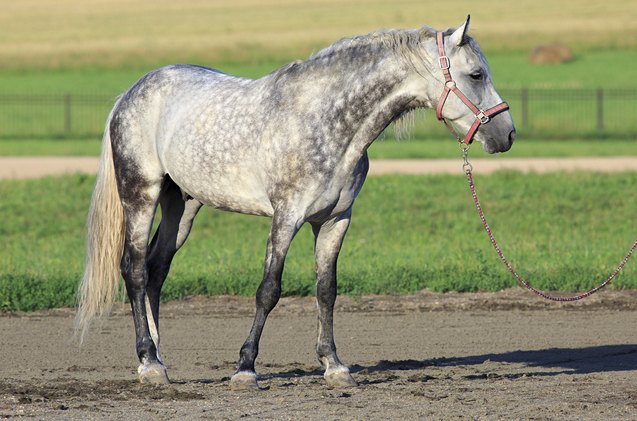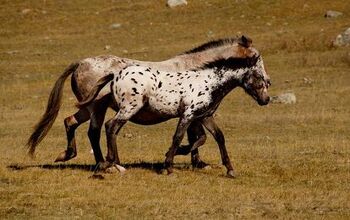Orlov Trotter


About Orlov Trotter
Also known as the Orloff Trotter, the Orlov Trotter is a popular equine breed from Russia. In fact, it is Russia’s most famous horse breed, and at one time, it was also the fastest harness horse in all of Europe.
Developed towards the end of the 18th century, this equine breed was originally used as a light harness horse, displaying both endurance and speed. It is named after the breed’s creator, Count A.G. Orlov. He was responsible for establishing the Khrenovsky Stud, which would be the foundation for this new breed. The farm that A.G. Orlov used is still open today.
The Orlov Trotter is Russia’s most famous horse breed.
In the 1770s, Orlov wanted to develop an equine breed that would be able to tolerate the severe climate in Russia. He also needed a horse that would be able to travel long distances and that would be able to handle the terrible roads in the country as well. Therefore, he focused on creating a new breed that would have a lot of endurance and would feature a long-strided trot. And on top of all of that, he wanted the horse to also be attractive.
Thanks to his expert knowledge of equines, his prestige, and his wealth, Orlov was able to acquire the finest horses from Persia, Arabia, the Caucasus, Turkey, Italy, Poland, Spain, Germany, Denmark, England, and Holland. The most famous of these acquisitions, however, was the Arabian stallion named Smetanka. This silver-gray beauty was long-backed and large for his breed, and he even had an extra rib, along with an ideal trot.
In a mere three generations, Orlov was able to create horses that exhibited the essential traits of what would be known as the Orlov Trotter. He kept meticulous performance and breeding records, as well as thousands of horses, and he also worked with many different potential lines at once.
In the 1830s, the monopoly on Orlov Trotter breeding started to break down. By the middle of the century, Orlov Trotters were being bred throughout Russia. And throughout the majority of the 19th century, no other equine trotting breed on the planet was able to match the Orlov Trotter’s stamina, hardiness, and speed. As a result, these horses developed a positive reputation and grew popular throughout Europe. In addition to being used in sport racing, and essentially introducing harness racing in Russia, they were also used as carriage horses.
Throughout the 20th century, Orlov Trotter bloodlines were diluted as these horses were bred with other horses, such as the American Standardbred. Situations like war also took their toll on the Orlov Trotter’s genetic pool. As a result, enthusiasts are working hard at preserving this breed today.
Despite its large size, power, surefootedness, agility, and speed, the Orlov Trotter can be considered a gentle giant, which is one of the many reasons why it is such a popular and unique breed.
These horses are highly versatile, so they can be trained to perform a variety of tasks. They are also willing animals that are happy to work.
The quiet temperament of the Orlov Trotter makes it a wonderful companion, whether you need a work horse, a sport horse, or a riding horse.
Orlov Trotters are born with a darker coat that changes with maturity.
When you look at an Orlov Trotter, you will notice that the horse has a large head with expressive, large eyes. The neck is naturally arched and long, and the chest is broad and deep. The body features well-sprung ribs and a long back, and it is muscular throughout. The legs are also strong, featuring tendons that are clearly defined, along with joints that are also prominent.
Overall, this breed is impressive, and it is very fast and agile. Its body allows it to be powerful, light, and elegant all at the same time. However, there are four main types of Orlov Trotters, and they are based upon their size. These are the large/massive, the large/rangy, the medium sized, and the average.
Orlov Trotters are willing horses that are happy to work.
The Orlov Trotter features several different coat colors that include white, black, chestnut, gray, and bay. Many, however, will be gray when they reach maturity because of their Arabian ancestry. Only roughly 5% of these horses will have a chestnut colored coat.
All of the horses, regardless of what color they display as adults, are actually born with a darker coat.
When it comes to grooming an Orlov Trotter, you can follow the same standard grooming process that you would use with any other horse. A hoof pick will ensure the horse’s hooves can be kept clean and free of injuries and infections, while a tail comb and mane brush will ensure that the hairs will remain soft, smooth, and tangle free.
In addition to equine shampoo and conditioner, you can thoroughly clean the skin and coat of your horse using other standard tools, such as a curry comb, a body finishing brush, a shedding blade, and a dandy brush.
Photo credit: Ponyart/Wikimedia; pirita/Depositphotos.com; yykkaa/Bigstock

Lisa Selvaggio is a freelance writer and editor, and our resident cats-pert, with certifications in pet nutrition and pet first aid. She enjoys producing content that helps people understand animals better so they can give their pets a safe and happy home.
More by Lisa Selvaggio
























